
Navigating the world of international shipping can feel complex, especially when you’re sending goods across the globe. If you’re planning to move items in a shipping container from India to USA, you’re likely focused on two things: safety and cost. With some planning and insider knowledge, you can make the process smooth and cost-effective.
Global trade between India and the United States is a major artery of the world’s economy, but that doesn’t mean you have to pay a fortune. The key is understanding the factors that influence shipping costs and making smart choices along the way. This guide will walk you through the best tips for securing an affordable shipping container from India to the USA, helping you save money without cutting corners.
Understand the Key Factors Influencing Shipping Costs
Before you can save money, you need to know where it’s going. The final price you pay for freight from India isn’t just one number. It’s a mix of different charges that vary based on several factors.
- Container Size: Standard containers come in 20-foot and 40-foot lengths. A 40-foot container offers more than double the space of a 20-foot one but isn’t twice the price, making it more cost-effective if you have a larger volume of goods.
- Shipping Method: You’ll primarily choose between ocean freight and air freight. For a full container, ocean freight is almost always the more economical choice.
- Transit Time: Faster shipping often comes with higher costs. If you can be flexible with your timeline, you can unlock significant savings.
- Time of Year: Shipping rates fluctuate with demand. Peak seasons, like the months leading up to major holidays, often see higher prices due to increased demand in the global supply chain.
- Ports of Origin and Destination: The specific ports you ship from in India and to in the USA will affect the price. Shipping to a major port on the West Coast, like Los Angeles, might have different shipping rates than a port on the East Coast.
- Duties and Taxes: These are unavoidable costs determined by the type and value of the goods being shipped from India.
Choose Ocean Freight for Maximum Savings
When it comes to moving a large volume of goods across the globe, you have two main shipping options: ocean freight or air freight. While air freight offers speed, it comes at a premium price. For anyone focused on affordability, ocean freight is the undisputed champion.
Sending your goods by sea is significantly cheaper, especially for bulky or heavy items that fill a container. The trade-off is a longer transit time. A shipment via ocean freight can take several weeks, whereas air freight might only take days. However, if you can plan your shipment well in advance, the savings from choosing the sea route are substantial. This makes ocean freight the go-to method for most people sending a shipping container from India to USA.
Be Smart About Your Container Choice
One of the biggest decisions you’ll make is whether to book a Full Container Load (FCL) or a Less Than Container Load (LCL).
- Full Container Load (FCL): You pay for the entire container, whether you fill it or not. This is ideal if you have enough goods to fill most of a 20-foot or 40-foot container. FCL is often more cost-effective per cubic meter and involves less handling, as your container is sealed at the origin and opened at the destination.
- Less than Container Load (LCL): You share container space with other shippers. You only pay for the volume your goods occupy. This is a great option for smaller shipments. However, the price per cubic meter is higher than FCL, and it can involve a longer transit time due to the logistics of consolidating and de-consolidating goods from multiple shippers.
To save money, calculate the volume of your goods. If you are close to filling a 20-foot container, opting for FCL might be cheaper and more secure than a large LCL shipment.
Plan and Ship During the Off-Season
The international shipping industry has peak seasons and off-seasons, just like the travel industry. Demand for shipping containers surges during certain times of the year, driving up prices.
Generally, the peak season for shipping from India to the USA runs from August to November, as businesses stock up for the holiday season. Shipping during the off-season, typically from January to May, can result in much lower shipping rates. By planning your move several months in advance, you can avoid this peak-season rush and secure a more affordable price for your container. Flexibility is your best friend when it comes to saving money.
Understand and Prepare for Customs, Duties, and Taxes
One area where costs can unexpectedly add up is customs clearance. Every shipment entering the United States must be cleared by U.S. Customs and Border Protection (CBP). This process involves paperwork, inspections, and the payment of any applicable duties and taxes.
Here’s how to manage these costs effectively:
- Accurate Paperwork: The most important step is to ensure all your documentation is complete and accurate. This includes the Bill of Lading, commercial invoice, and packing list. Errors or omissions can lead to costly delays, storage fees, and even fines.
- Declare Everything Honestly: Under-declaring the value of your goods to try and save on duties is a risky strategy that can backfire badly. Be honest and accurate in your declarations to ensure a smooth customs clearance process.
- Know Your Goods: Different items have different duty rates. Research the Harmonized System (HS) codes for your items to get an estimate of the duties you’ll need to pay.
- Work with a Professional: A reliable shipping partner or customs broker is invaluable here. They understand the nuances of the customs process and can help ensure your shipment complies with all regulations, preventing unforeseen expenses.
FAQ: How Long Does it Take to Ship a Container from India to the USA?
The transit time for a shipping container from India to USA typically ranges from 30 to 50 days for ocean freight. This duration varies based on several factors, including the specific ports of origin and destination, the shipping line’s schedule, weather conditions, and the time required for customs clearance. For example, a port-to-port journey from Mumbai to a west coast port like Los Angeles is generally faster than one to an east coast port.
Get Multiple Quotes, But Don’t Just Choose the Cheapest
It’s wise to shop around and get quotes from a few different logistics providers. However, don’t let price be your only guide. The cheapest quote might come with hidden costs, poor service, or unreliable transit times that can disrupt the entire supply chain of your move.
When comparing quotes, look for transparency. A good quote should clearly break down all the costs involved:
- The base ocean freight rate.
- Port charges at both the origin and the destination.
- Fuel surcharges.
- Fees for documentation and customs clearance.
- Costs for inland transportation (if needed).
A slightly higher quote from a reputable company with excellent reviews and transparent pricing can save you money and stress in the long run. They can provide a more seamless experience for all aspects of international shipping, from the initial booking to the final delivery.
Pack Your Container Efficiently
How you pack your goods can also impact the cost. For LCL shipments, your cost is based on the volume of your goods, so packing tightly and efficiently can reduce the space you need and lower your bill. For FCL shipments, proper packing protects your items from damage during transit, saving you the cost of replacing broken goods.
Use sturdy boxes, wrap fragile items carefully, and distribute weight evenly throughout the container. A well-packed container is less likely to shift during its long journey across the ocean, ensuring your items arrive in the same condition they were in when they were shipped from India.
Final Thoughts on Affordable Shipping
Sending a shipping container from India to USA doesn’t have to break the bank. By being strategic and informed, you can significantly reduce your shipping costs. Remember to choose ocean freight over air freight, be smart about your container size, and plan your shipment during the off-season. Pay close attention to the details of customs clearance to avoid unexpected fees, and always partner with a trustworthy logistics expert. By following these tips, you can ensure your goods make the journey safely, efficiently, and affordably.
Ready to start planning your shipment with a team that understands how to make international shipping simple and cost-effective? Get a free, no-obligation quote from Universal Relocations today and let our experts guide you through every step of the process.

 800-13-7356
800-13-7356
